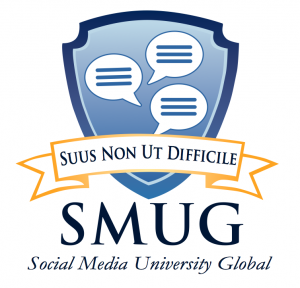The response to the contest to choose an official seal for SMUG was tremendous, with lots of votes, comments and #smugseal tweets. Given my personal lack of graphic artistry, I appreciate so much the entries from those who took time and thought to capture the essence of SMUG. They took different approaches, from old-school ivy-covered #3 to the global longitude/latitude look of #2 (with lots of mini-logos from social media sites) to a pair from Ruth LaGue that both polled strong, one with a circular motif and the other with a shield and our Latin motto.
Entry 4 was the clear winner in the semifinal, and now advances to be considered along with another strong entry (which had been in the works in response to the previous call for entries but had not been submitted.)
So here are your finalists (click each image to view enlarged versions):


Cast your votes in the poll in the sidebar, or vote via Twitter using the #smugseal hashtag (which will help spread the word about the contest and about SMUG).
Feel free also to add your comments below, if you have suggestions on how either version might be tweaked or suggestions for logo merchandise you’d like to see.
Thanks again to Amy Kapinus and Reed Smith for their contributions, and to Ruth LaGue and Fatima Mekkaoui for their finalist entries.
Voting runs through 11:59 p.m. CDT on Saturday, August 8.
Cast your vote now!











